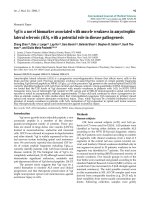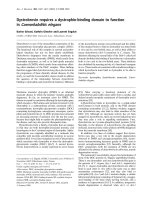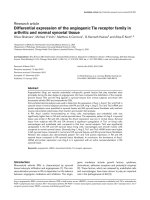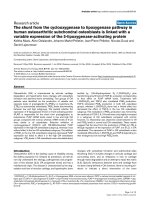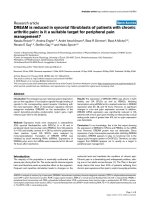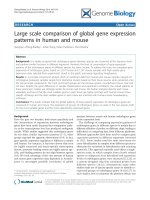Báo cáo y học: "Chromothripsis is a common mechanism driving genomic rearrangements in primary and metastatic colorectal cancer" pdf
Bạn đang xem bản rút gọn của tài liệu. Xem và tải ngay bản đầy đủ của tài liệu tại đây (2.44 MB, 29 trang )
This Provisional PDF corresponds to the article as it appeared upon acceptance. Copyedited and
fully formatted PDF and full text (HTML) versions will be made available soon.
Chromothripsis is a common mechanism driving genomic rearrangements in
primary and metastatic colorectal cancer
Genome Biology 2011, 12:R103 doi:10.1186/gb-2011-12-10-r103
Wigard P Kloosterman ()
Marlous Hoogstraat ()
Oscar Paling ()
Masoumeh Tavakoli-Yaraki ()
Ivo Renkens ()
Joost S Vermaat ()
Markus J van Roosmalen ()
Stef van Lieshout ()
Isaac J Nijman ()
Wijnand Roessingh ()
Ruben van 't Slot ()
Jose van de Belt ()
Victor Guryev ()
Marco Koudijs ()
Emile Voest ()
Edwin Cuppen ()
ISSN 1465-6906
Article type Research
Submission date 21 July 2011
Acceptance date 20 October 2011
Publication date 20 October 2011
Article URL />This peer-reviewed article was published immediately upon acceptance. It can be downloaded,
printed and distributed freely for any purposes (see copyright notice below).
Articles in Genome Biology are listed in PubMed and archived at PubMed Central.
For information about publishing your research in Genome Biology go to
Genome Biology
© 2011 Kloosterman et al. ; licensee BioMed Central Ltd.
This is an open access article distributed under the terms of the Creative Commons Attribution License ( />which permits unrestricted use, distribution, and reproduction in any medium, provided the original work is properly cited.
/>Genome Biology
© 2011 Kloosterman et al. ; licensee BioMed Central Ltd.
This is an open access article distributed under the terms of the Creative Commons Attribution License ( />which permits unrestricted use, distribution, and reproduction in any medium, provided the original work is properly cited.
1
Chromothripsis is a common mechanism driving genomic rearrangements in primary
and metastatic colorectal cancer
Wigard P Kloosterman,
1
Marlous Hoogstraat,
1,2
Oscar Paling,
2
Masoumeh Tavakoli-Yaraki,
1
Ivo Renkens,
1
Joost Vermaat,
2
Markus J van Roosmalen,
1
Stef van Lieshout,
1,2
Isaac J Nijman,
3
Wijnand Roessingh,
2
Ruben van ‘t Slot,
1
José van de Belt,
1
Victor Guryev,
3
Marco Koudijs,
2
Emile Voest
2
and Edwin Cuppen,
1,3,*
1
Department of Medical Genetics, University Medical Center Utrecht, Universiteitsweg 100,
Utrecht, 3584 CG, The Netherlands
2
Department of Medical Oncology, University Medical Center Utrecht, Universiteitsweg 100,
Utrecht, 3584 CG, The Netherlands
3
Hubrecht Institute KNAW and University Medical Center Utrecht, Uppsalalaan 8, Utrecht,
3584 CT, The Netherlands
*
Correspondence:
2
Abstract
Background
Structural rearrangements form a major class of somatic variation in cancer genomes. Local
chromosome shattering, termed chromothripsis, is a mechanism proposed to be the cause of
clustered chromosomal rearrangements and was recently described to occur in a small
percentage of tumors. The significance of these clusters for tumor development or metastatic
spread is largely unclear.
Results
We used genome-wide long mate-pair sequencing and SNP array profiling to reveal that
chromothripsis is a widespread phenomenon in primary colorectal cancer and metastases.
We find large and small chromothripsis events in nearly every colorectal tumor sample and
show that several breakpoints of chromothripsis clusters and isolated rearrangements affect
cancer genes, including NOTCH2, EXO1 and MLL3. We complemented the structural
variation studies by sequencing the coding regions of a cancer exome in all colorectal tumor
samples and found somatic mutations in 24 genes, including APC, KRAS, SMAD4 and
PIK3CA. A pairwise comparison of somatic variations in primary and metastatic samples
indicated that many chromothripsis clusters, isolated rearrangements and point mutations are
exclusively present in either the primary tumor or the metastasis and may affect cancer genes
in a lesion-specific manner.
Conclusions
We conclude that chromothripsis is a prevalent mechanism driving structural rearrangements
in colorectal cancer and show that a complex interplay between point mutations, simple copy
number changes and chromothripsis events drive colorectal tumor development and
metastasis.
Keywords
Chromosome shattering, structural variation, colorectal cancer, metastasis, somatic mutations
3
Background
Colorectal cancer develops from a benign adenomatous polyp into an invasive cancer, which
can metastasize to distant sites such as the liver [1]. Tumor progression is associated with a
variety of genetic changes and chromosome instability often leads to loss of tumor
suppressor genes, such as APC, TP53 and SMAD4.
High-throughput DNA sequencing has indicated that there are between 1,000 and
10,000 somatic mutations in the genomes of adult solid cancers [2-5]. Furthermore, next-
generation sequencing has revolutionized our possibilities to profile genetic changes in
cancer genomes, yielding important insights into the genes and mechanisms that contribute
to cancer development and progression [5, 6]. Systematic sequence analysis of coding
regions in primary and metastatic tumor genomes has shown that little mutations are required
to transform cells from an invasive colorectal tumor into cells that have the capability to
metastasize [7]. Similarly, only two new mutations were identified in a brain metastasis
compared to a primary breast tumor [8]. These data suggest that essential mutations needed
for cancer progression occur predominantly in the primary tumor genome before initiation of
metastasis [9]. In line with this hypothesis is the finding that distinct clonal cell populations in
primary pancreatic carcinoma can independently seed distant metastases [10]. However,
marked genetic differences between primary carcinomas and metastatic lesions do exist [11],
and genotyping of rearrangement breakpoints in primary and metastatic pancreatic cancer
revealed ongoing genomic evolution at metastatic sites [12].
In particular the impact and contribution of structural genomic changes to cancer
development has recently received considerable attention [8, 13-15]. Many solid tumor
genomes harbour tens to hundreds of genomic rearrangements, which may drive tumor
progression by disruption of tumor suppressor genes, formation of fusion proteins,
constitutive activation of enzymes or amplification of oncogenes [12-17]. Rearrangements
may be complex, involving multiple inter- and intra-chromosomal fusions and often reside in
regions of gene-amplification [13, 18, 19]. Recent genome-wide copy number profiling of
cancer genomes suggests that 2-3% of all cancers appear to contain very complex
rearrangements associated with two copy number states [20, 21]. These events involve
complete chromosomes or chromosome arms and are proposed to result from massive
4
chromosome shattering, termed chromothripsis [20, 21]. The prevalence and impact of such
complex rearrangements in heterogeneous clinical specimens of solid tumors as well as their
relevance for metastasis formation is currently unclear.
Here, we describe pairwise genomic analyses of matched primary and metastatic
colorectal cancer samples from four patients using genome-wide mate-pair sequencing, SNP
array profiling and targeted exome sequencing to explore the genetic changes that constitute
colorectal cancer formation and metastasis. We find marked differences between primary and
metastatic tumors and show that chromothripsis rearrangements occur frequently in
colorectal cancer samples. We conclude that chromothripsis events, along with simple point
mutations and structural changes, are major contributors to somatic genetic variation in
primary and metastatic colorectal cancer.
5
Results and discussion
Patterns of structural variation in primary and metastatic colorectal tumors
Paired-end sequencing has proven a powerful technique to profile genomic
rearrangements in cancer genomes [13]. However, there are some limitations associated with
the use of short insert paired-end libraries for detecting structural variation [22]. Long-insert
paired-end sequencing (also known as long mate-pair sequencing) has the advantage of
being able to detect structural changes across repetitive and duplicated sequences [19].
To study the landscape of structural genomic changes in fresh tumor samples, we
applied genome-wide long mate-pair sequencing and complementary SNP array profiling to
matching primary and metastatic colorectal cancer biopsies from four patients (Table 1,
Additional file 1, Materials and Methods). Parallel analysis of normal tissues allowed us to
efficiently detect de novo somatic rearrangements in the genomes of primary and metastatic
lesions. Per sample, we generated between 10 and 65 million mate-pair sequence reads with
an average insert size of 2.5–3kb, resulting in 10x to 48x average physical genome coverage
per sample (Additional file 2, Additional file 3). We identified 352 somatically acquired
rearrangements in the four patients, including deletions (177), tandem duplications (39),
inversions (58), and interchromosomal rearrangements (78) (Figures 1a and b, Additional file
4). We independently confirmed the tumor-specific presence of 222 structural changes by
PCR across the rearrangement breakpoint. Intrachromosomal rearrangements were
particularly prevalent in our colorectal tumor samples, similar to what has been described for
other tumor types (Figure 1b) [12, 14, 16]. Deletion-type rearrangements formed the most
common class of rearrangements, with small deletions (up to 5 kb) being more common than
large deletions (Additional file 5). This is in contrast to primary breast cancer genomes, for
which tandem duplications form the most common rearrangement class and deletions form
the second largest class [14].
Since we sequenced both primary tumor genomes and liver metastases as well as
control tissue, we could distinguish between rearrangements that were specific to both or one
of these lesions. For all 222 confirmed rearrangements, we performed PCR-based breakpoint
sequencing in primary tumor, metastasis and control samples (normal liver and normal colon
tissue). The sensitivity of detecting a breakpoint by PCR is below 0.001% and should
6
therefore be a reliable estimate of the presence of a rearrangement in DNA from a highly
heterogeneous tumor sample [23]. Based on PCR-based breakpoint sequencing we found
that, depending on the patient, between 32 to 95% of all rearrangements were specific to
either the primary tumor or the metastasis (Figure 1c). There are several potential
explanations for the observed differences between primary and metastatic sites: (i) changes
could have occurred in the primary tumor and metastasis after dissemination to the liver, (ii)
the part of the primary tumor sample that we analyzed did not contain the cells that were
giving rise to the metastasis, (iii) metastatic tumor cells may have lost rearrangements that
occurred in the primary tumor, and (iv) PCR may not be sensitive enough to detect
breakpoints in very low numbers of cells, such as subclones in the primary tumor that may
have given rise to the metastasis [10]. Given the significant overlap in somatic structural
changes between primary tumors and corresponding metastases (5%-68%, Figure 1c), we
reason that many rearrangements arose in the primary tumor before metastatic spread.
These overlapping rearrangements within a patient may represent early somatic
rearrangements within the primary parental clone [10]. Subsequent genomic instability in the
metastatic lesion may have lead to additional structural changes on top of the ones that were
found in the primary tumor [12]. The many primary-tumor specific rearrangements likely arose
after dissemination to the liver or were present in subclones of the primary tumor that did not
have the capability to metastasize. Taken together, our pairwise comparison of structural
changes in colorectal tumors shows that primary and metastatic colorectal cancer genomes
have rearrangements in common, but also harbour distinct patterns of structural variation.
Chromothripsis is common mechanism driving structural changes in primary and
metastatic colorectal tumors
Mate-pair sequencing allows identification of rearrangement breakpoints at nucleotide
resolution. Furthermore, mate-pair signatures involved in complex patterns of structural
changes may be used to reconstruct rearranged chromosomes by linking chromosomal
fragments together based on their relative orientation. We have previously used mate-pair
information to resolve a complex chromothripsis event in the germline [24].
7
Close examination of the landscape of genomic rearrangements in primary and
metastatic samples, revealed chromosomal locations where breakpoints form complex
clusters (Figure 2, Additional file 6). There are several mechanisms that may account for the
occurrence of complex rearrangements in cancer genomes [18, 21, 25]. Complex
rearrangement patterns have been found in cancer amplicons [18], which may result from the
breakage-fusion-bridge cycle following telomere dysfunction [25, 26]. We do not find evidence
for genomic amplification of regions involved in the complex clusters found here. Therefore,
we regard it unlikely that these complex rearrangements are a result of the breakage-fusion-
bridge cycle. As outlined below, we find that several complex clusters identified here,
resemble the chromothripsis rearrangements described recently [21].
Clusters contain short and large chromosomal fragments that have head and tail
sides connected to other distant chromosomal fragments as exemplified for the cluster
involving chromosomes 15 and 20 in patient 3 (Figure 2d). Furthermore, the inter- and
intrachromosomal breakpoints of this cluster and most other clusters (chr 17-21, chr 3-6, chr
13) are associated with copy number changes (Additional file 7), leading to two copy numbers
states: high for retained fragments (i.e. with head and tail sides connected to other
chromosomal fragments) and low for lost fragments (no connection to other fragments)
(Figure 2d). Such alternated high and low copy number states are a striking feature of
chromothripsis clusters identified previously [21]. However, the copy number changes we
observed were not always as pronounced as previously reported [21]. This may be due to the
fact that we studied heterogeneous tumor biopsies in our study as compared to clonally
derived homogeneous cell lines in the previous study.
For the clusters on chromosome 1 in patient 3, chromosomes 3 and 6 in patient 4
and chromosomes 17 and 21 in patient 4, we observed that cluster boundaries extend to
telomeric regions (Additional file 8), representing another characteristic that has been
described as a hallmark of chromothripsis [21].
Based on sensitive PCR genotyping of breakpoints, several chromothripsis clusters
displayed exclusive presence in either the primary tumor or the metastasis (Figure 2,
Additional file 9, Additional file 10 and Additional file 4), further supporting the notion that they
8
occurred as single simultaneous events, since a progressive model would more likely have
resulted in the presence of at least some of the breakpoints in the corresponding lesion.
Capillary sequencing of PCR fragments across breakpoints allowed us to determine
sequence characteristics of breakpoint regions. We characterized 159 fusion points at
nucleotide resolution (Additional file 11), of which 69 fall within complex chromothripsis
clusters. There were no major differences in breakpoint characteristics for rearrangements
within or outside complex clusters. Overall, we found that 38% were blunt-ended fusions and
another 40% contained several nucleotides of microhomology, the majority of the fusion
points having microhomology of 1-3 bp. For 22% of fused segments we observed insertions
of short nucleotide stretches, mostly below 6 bp, which likely represent non-templated
nucleotides, which are often seen for double-stranded breaks repaired by non-homologous
end-joining [27, 28]. Next, we determined the overlap of breakpoints with repeat annotation
(LINE, SINE, LTR, DNA repeat). However, we could not identify significant association of
somatic breakpoints with any of these repeat classes, when compared to a set of randomly
sampled positions across the genome (Fisher exact, P=0.5). The sequence characteristics of
fusion points that we observed here resemble those that have been detected in various other
cancers [12, 14, 15, 19], and are in line with a process of non-homologous end-joining-
mediated repair of double-stranded DNA breaks [21, 27, 28].
Overall, we conclude that small and large chromothripsis events result from massive
double-stranded breaks and are frequently occurring in primary and metastatic colorectal
cancer.
Chromothripsis cluster contribute to tumorigenesis in conjunction with point
mutations, copy number changes and structural rearrangements
Recent studies have shown that complex rearrangements may promote cancer
progression through disruption of tumor suppressor genes, or generation of fusion genes [14,
15, 19, 21]. In addition, cancer amplicons frequently center on oncogenes, such as ERBB2
and MYC [18]. To understand the contribution of chromothripsis clusters to tumor growth and
metastasis, we analysed the breakpoint regions for the presence of cancer genes. One
breakpoint of the cluster on chromosome 1 in patient 3 disrupts the fumarate hydratase gene
9
(FH), which is a tumor suppressor frequently mutated in renal cell cancer (Figure 3a) [29].
Another rearrangement in the same cluster disrupts EXO1, which has tumor suppressor
activity and may act together with APC to promote gastrointestinal tumor formation [30]. In
patient 1, we identified a cluster on chromosome 13, and one of the breakpoints disrupts
MYCBP2 (Figure 3b). In addition, there are several cancer related genes from the Cancer
Gene Census within the boundaries of this cluster and these may be affected by one of the
numerous rearrangements in this cluster [31]. Besides complex clusters, we identified a range
of isolated structural rearrangements for which breakpoints affect cancer genes, such as
NOTCH2, FHIT, MLL3 and ETV6 (Additional file 4) [31]. We also detected several genes,
which form hotspots of rearrangements in several patients (Additional file 12). For example,
PARK2 is a tumor suppressor gene, which is known to contain frequent deletions in colorectal
cancers [32]. We identified several independent deletions of PARK2 in primary and metastatic
tumors of patient 3 and 4. Although PARK2 lies in a common fragile site, which explains the
frequent deletions in this gene, it may function as a tumor suppressor and disruption of Park2
increases adenoma development in Apc mutant mice [32, 33]. Interestingly, patient 4 carries
two independent APC point mutations in the primary tumor and the metastasis respectively
(see below and Table 2). We also identified several independent rearrangements in FHIT,
WWOX, PRKG1 and MACROD2 in multiple patients. All of these genes are located at
common fragile sites and have been found to contain rearrangements in several cancers [12,
34].
To get insight into the contribution of point mutations to tumor development in these
and other cancer-relevant genes in our tumor samples, we performed next-generation
sequencing based mutational profiling of a cancer mini-exome in all 16 tumor and control
samples (1296 genes, Materials and Methods). We found canonical disrupting mutations in
APC, TP53, SMAD2 and SMAD4 as well as KRAS (G12A) activation in several patients
(Table 2) [1]. For patient 2 we identified the same mutations in KRAS, APC and PTPRF in
both primary and metastatic tumor. However, mutations in SMAD2 and SMAD4 could only be
detected in DNA from the metastatic tissue. In contrast, the tumor genomes of patient 4
contained mutation in APC, KRAS and TP53, but both primary tumor and metastasis carried
their own private mutations in these genes. These data complement the mate-pair and copy
10
number data, which also show overlapping mutations but also many distinct genetic variations
in primary and metastatic samples, which may affect cancer genes in a lesion-specific
manner (Figure 1c). For example, we identified metastasis-specific recurrent deletions of
CASP3 and SORBS2 or deletion of CSMD1 (Figure 3c and 3d) [35, 36]. Interestingly,
SORBS2, which is also known as ArgBP2, is repressed during oncogenic transformation of
the pancreas and the protein was implicated in cell adhesion and migration [36]. Furthermore,
CSMD1 mutations have been found in particularly in advanced colorectal tumors, suggesting
a role in metastasis formation [35]. Therefore, the distinct genetic changes in metastastic
samples compared to corresponding primary tumors, likely contribute to metastasis formation
or provide advantage to tumor growth at metastatic sites (liver).
These data emphasize that comprehensive genetic analysis at the nucleotide as well
as structural level, of both primary tumor and metastasis is needed to outline an effective
targeted treatment strategy for colorectal cancer.
Conclusions
Our data show that clusters of complex genomic rearrangements occur frequently in
primary and metastatic colorectal tumors. Based on the features of these complex
rearrangement clusters, we find that chromothripsis is a common driver of genetic changes in
colorectal cancer. We conclude that complex chromothripsis events in conjunction with simple
copy number changes and point mutations shape the dynamic architecture of colorectal
cancer genomes and all together provide the genetic basis for tumor growth and metastasis.
Therefore, the impact of chromothripsis on tumor development and evolution may be greater
than previously anticipated [21].
The molecular mechanisms that drive chromothripsis are unclear, but the
characteristics of break points suggest that chromosome shattering occurred randomly, yet
regionally, as a result from double stranded breaks and chromosomal fragments are likely
repaired by non-homologous end-joining [21, 24]. If the reshuffling of genetic information
poses any benefit to the cell, chromothripsis clusters may drive tumor formation and
metastases. A complex cluster could also be a passive genetic event, for example when
coinciding with a growth promoting mutation in the same cell. While the observation that
11
some complex clusters are uniquely present in primary or metastatic lesions could be
supportive of this hypothesis, it could also be that chromothripsis events provide a selective
advantage specific for the molecular environment of either the primary tumor or the
metastasis.
The distinct genetic mutation patterns in primary and metastatic tumors, illustrate the
need for much more comprehensive screening of cancer genomes than is currently common
practice, including profiling of (complex) structural changes along with coding mutations in
primary and metastatic lesions.
12
Materials and methods
Samples
The research in this study conformed to the Declaration of Helsinki of the World Medical
Association concerning human material/data and experimentation. The Medical Ethics
Committee (METC) of the University Medical Centre Utrecht, The Netherlands approved the
genetic analysis of DNA from tumor and normal tissues of the patients described in this paper.
Tissue samples were previously acquired as part of a series of routine diagnostic and
pathological analyses in our hospital.
We performed mate-pair sequencing on DNA from tumor biopsies and control samples from 4
patients with colorectal adenocarcinoma attending University Medical Center Utrecht, The
Netherlands. For each patient, we obtained DNA from the primary colon tumor, normal colon
tissue, liver metastasis and normal liver tissue. We assessed tumor content of biopsies by
microscopic analysis of stained cryosections (tumor content >80%).
Preparation of mate-pair libraries and SOLiD sequencing
Mate-paired libraries were generated from 50-100µg DNA isolated from tumor and control
samples. Mate-pair library preparation was essentially as described in the SOLiDv3.5 library
preparation manual (Applied Biosystems). We performed two genomic DNA size selections
per library: one after shearing and one after CAP adaptor ligation. Libraries were cloned and
384 clones per library were picked for capillary sequencing to assess presence of adaptors,
insert sizes and chimeric molecules. Chimeric molecules were identified based on a tag
distance > 100kb. On average, we observed between 5-15% present chimeric molecules per
library. We sequenced 2x 50bp mates for each library on one or two quadrants of a SOLiD V4
sequencing slide. Mate-pair sequencing data are available from the European Nucleotide
Sequence Read Archive (ENA SRA) under accession number ERP000875.
Bioinformatic analysis of mate-pair reads
The F3 and R3 mate-pair tags were mapped independently to the human reference genome
(GRCh37/hg19) using BWA software V0.5.0 with the following settings: -c -l 25 -k 2 -n 1 [37].
13
Mate-pair tags with unambiguous mapping were combined and split into local (<100kb) and
remote (>100kb) mate-pair sets. Local mate-pairs were further split into mate-pairs with
normal orientation of the tags relative to each other, mate-pairs with inverted tags and mate-
pairs with everted tags [24].
Deletions were called from local mate-pairs with correct orientation and with a mate-pair span
in the top 0.5% percentile of the mate-pair size distribution. Tandem duplications were called
from local mate-pairs with everted orientation and inversions were called from local mate-
pairs with inverted orientation. Mate-pairs were clustered based on overlapping mate-pairs
with a maximal tag distance of 2 times the average library insert size. The remote (inter-
chromosomal and intra-chromosomal > 100kb) mate-pairs were clustered independently of
the relative orientation of the mate-pair tags. The orientation of the different mate-pair tags in
a cluster relative to each other is indicated by H (or h for the minus strand) when the tag has
its ‘head’ side (the side that points towards the start of the chromosome) opposed to the
pairing tag and T (or t for the minus strand) when a tag has its ‘tail’ side (the side that points
towards the end of the chromosome) opposed to the pairing tag. Mate-pair clustering was
performed per patient (4 samples) and tumor-specific rearrangements were selected based
on clusters without overlapping mate-pairs derived from normal tissue samples. Tumor-
specific rearrangements were confirmed by PCR across the breakpoint in primary tumor,
metastasis and normal liver and colon samples. Rearrangement fusion points were visualized
by Circos software [38].
SNP-array analysis
DNA from all 16 tumor and control samples was analyzed by Illumina Cyto12 SNP arrays
according to standard procedures (Illumina). Copy number changes and allelic profiles were
derived from log R ratios and B allele frequencies that are provided by the Illumina
Genomestudio package. Since overall copy number changes in the heterogeneous samples
that we analyzed are not as marked as in clonally derived cell lines, we used custom scripts
to detect areas with low or high log R ratio values (increase in copy number is defined as: a
positive shift (> 0.1) in average log R ratio compared to a control sample (healthy colon or
liver tissue from the same patient), and a decrease in copy number is defined as a negative
14
shift (> 0.1) in log R ratio compared to the control sample. For both positive and negative
changes, we required at least 12 consecutive deviating probes, while allowing a maximum of
2 probes that do not meet the criterion. Copy number changes were further substantiated by
changes in average B allele frequency for heterozygous positions relative to control samples
(average B allele frequency shift larger than 0.05, also found in a minimum of 12 sequential
probes, including a 2 probe 'mismatch' cut-off). The resulting copy variable regions were
manually curated based on B allele frequency plots and log R ratio plots of tumors and
matching healthy samples. SNP-array data were submitted to the NCBI GEO archive and are
available under accession number GSE32711.
Mutational profiling
Mutational analysis of 1296 kinases and cancer-related genes was performed by multiplexed
enrichment of barcoded fragment libraries from all 16 samples [39]. Capturing was done
using a custom-designed Agilent 244K array with 60-mer tiled probes on both strands [40].
The pool of enriched libraries was sequenced on one slide of a SOLiD3.5 instrument. Data
were mapped to the reference genome (GRCh37/hg19) using BWA (-c -l 25 -k 2 -n 1). SNP
calling was done using a custom analysis pipeline that identifies mutations with a non-
reference allele frequency larger than 15% and a coverage of at least 10x. Sequencing data
are available from the European Nucleotide Sequence Read Archive (ENA SRA) under
accession number ERP000875. All identified variants were validated by PCR and capillary
sequencing.
Competing interests
The authors declare that they have no competing interests
Authors’ contributions
WK conceived and designed the study and performed the experiments and bioinformatic
analysis and wrote the paper. MH performed bioinformatic analysis of array data. OP
performed the breakpoint sequencing and analyzed the data. MT generated mate-pair
libraries. IR performed SOLiD sequencing and generated fragment libraries. JV designed the
15
study and contributed patient material. MR performed analysis of mate-pair sequencing data.
SL performed analysis of targeted-exome sequencing data. IN performed analysis of
targeted-exome sequencing data and designed the capture array. WR performed breakpoint
sequencing. RS performed SNP array analysis. JB generated mate-pair libraries. VG
performed analysis of mate-pair sequencing data. MK analyzed breakpoint regions and
supervised experiments. EV conceived and supervised the study and wrote the paper. EC
conceived, designed and supervised the study and wrote the paper.
Acknowledgements
This work was financially supported by the Cancer Genomics Center (CGC) program of the
Netherlands Genomics Initiative (NGI). We thank Martin Poot for critically reading the
manuscript.
16
Figure legends
Figure 1. Rearrangements in colorectal tumors detected by long mate-pair sequencing.
(a) Circos plots displaying rearrangements and their chromosomal location in primary and
metastatic colorectal tumor samples. Rearrangement fusion points and orientations are
indicated by coloured links: red, head-head; blue, tail-head; green, head-tail; orange, tail-tail
(low coordinate to high coordinate). Chromosome ideograms are shown on the outer ring.
The inner two rings show copy number profiles based on log R ratios derived from SNP array
analysis. Red copy number plots correspond to the liver metastasis and blue plots correspond
to the primary tumor. Copy number variation for matching normal colon and liver tissue are
plotted in black.
(b) Classes of rearrangements identified in tumors of the four patients. Deletion-type
rearrangements have tail-head orientation, tandem duplication type rearrangements have
head-tail orientation and inverted rearrangements have head-head or tail-tail orientation.
(c) Lesion-specific presence of rearrangements in primary and metastatic tumors as based on
PCR genotyping of samples for primary tumor, metastasis and control tissue.
Figure 2. Examples of clusters of rearrangements in primary and metastatic tumor genomes.
(a) A cluster of rearrangements involving chromosomes 3 and 6 specific for the primary tumor
of patient 4.
(b) A cluster of rearrangements on chromosome 13, which could be found in both the primary
tumor and the liver metastasis of patient 1.
(c) A metastasis-specific cluster of rearrangements involving chromosomes 17 and 21 of
patient 4. Orientations of fusions are coloured as in Fig. 1. Red copy number plots and B
allele frequencies correspond to the liver metastasis and blue plots correspond to the primary
tumor. Copy number variation and B allele frequencies for matching normal colon and liver
tissue are plotted in black.
(d) Breakpoints and copy number changes involving a cluster of rearrangements on
chromosomes 15 and 20 in the primary tumor genome of patient 3. The upper panel shows a
nucleotide resolution map of fusion points for this cluster. Lines indicate fusions between
17
chromosomal fragments. Genomic coordinates indicate positions of breakpoints.
Chromosomal fragments with both head and tail side connected to other fragments are
retained, while fragments that lack any link (fusion) are supposed to be deleted. This
expected pattern of retained and deleted fragments is reflected by the copy number profile for
chromosome 15 (lower panel).
Figure 3. Cancer-related genes affected by rearrangements breakpoints.
(a) Disruption of EXO1 and FH (fumarate hydratase) by rearrangement breakpoints in a
metastasis-specific cluster on chromosome 1 in patient 3.
(b) Disruption of MYCBP2 by a rearrangement breakpoint in a cluster on chromosome 13 in
patient 1. Genes from the Cancer Genome Census are also depicted for this cluster.
(c) Disruption of SORBS2 by metastasis-specific deletions in patients 2 and 4.
(d) Disruption of CSMD1 by a metastasis-specific deletion in patient 2.
18
References
1. Markowitz SD, Bertagnolli MM: Molecular origins of cancer: Molecular
basis of colorectal cancer. The New England journal of medicine 2009,
361:2449-2460.
2. Greenman C, Stephens P, Smith R, Dalgliesh GL, Hunter C, Bignell G, Davies
H, Teague J, Butler A, Stevens C, et al: Patterns of somatic mutation in
human cancer genomes. Nature 2007, 446:153-158.
3. Sjoblom T, Jones S, Wood LD, Parsons DW, Lin J, Barber TD, Mandelker D,
Leary RJ, Ptak J, Silliman N, et al: The consensus coding sequences of
human breast and colorectal cancers. Science 2006, 314:268-274.
4. Wood LD, Parsons DW, Jones S, Lin J, Sjoblom T, Leary RJ, Shen D, Boca SM,
Barber T, Ptak J, et al: The genomic landscapes of human breast and
colorectal cancers. Science 2007, 318:1108-1113.
5. Stratton MR: Exploring the genomes of cancer cells: progress and
promise. Science 2011, 331:1553-1558.
6. McDermott U, Downing JR, Stratton MR: Genomics and the continuum
of cancer care. The New England journal of medicine 2011, 364:340-350.
7. Jones S, Chen WD, Parmigiani G, Diehl F, Beerenwinkel N, Antal T,
Traulsen A, Nowak MA, Siegel C, Velculescu VE, et al: Comparative lesion
sequencing provides insights into tumor evolution. Proceedings of the
National Academy of Sciences of the United States of America 2008,
105:4283-4288.
8. Ding L, Ellis MJ, Li S, Larson DE, Chen K, Wallis JW, Harris CC, McLellan MD,
Fulton RS, Fulton LL, Abbott RM, Hoog J, Dooling DJ, Koboldt DC, Schmidt
H, Kalicki J, Zhang Q, Chen L, Lin L, Wendl MC, McMichael JF, Magrini VJ,
Cook L, McGrath SD, Vickery TL, Appelbaum E, Deschryver K, Davies S,
Guintoli T, et al: Genome remodelling in a basal-like breast cancer
metastasis and xenograft. Nature 2010, 464:999-1005.
9. Klein CA: Parallel progression of primary tumours and metastases.
Nature reviews Cancer 2009, 9:302-312.
10. Yachida S, Jones S, Bozic I, Antal T, Leary R, Fu B, Kamiyama M, Hruban
RH, Eshleman JR, Nowak MA, Velculescu VE, Kinzler KW, Vogelstein B,
Iacobuzio-Donahue CA: Distant metastasis occurs late during the
genetic evolution of pancreatic cancer. Nature 2010, 467:1114-1117.
11. Shah SP, Morin RD, Khattra J, Prentice L, Pugh T, Burleigh A, Delaney A,
Gelmon K, Guliany R, Senz J, Steidl C, Holt RA, Jones S, Sun M, Leung G,
Moore R, Severson T, Taylor GA, Teschendorff AE, Tse K, et al: Mutational
evolution in a lobular breast tumour profiled at single nucleotide
resolution. Nature 2009, 461:809-813.
12. Campbell PJ, Yachida S, Mudie LJ, Stephens PJ, Pleasance ED, Stebbings LA,
Morsberger LA, Latimer C, McLaren S, Lin ML, McBride DJ, Varela I, Nik-
Zainal SA, Leroy C, Jia M, Menzies A, Butler AP, Teague JW: The patterns
and dynamics of genomic instability in metastatic pancreatic cancer.
Nature 2010, 467:1109-1113.
13. Campbell PJ, Stephens PJ, Pleasance ED, O'Meara S, Li H, Santarius T,
Stebbings LA, Leroy C, Edkins S, Hardy C, Teague JW, Menzies A,
Goodhead I, Turner DJ, Clee CM, Quail MA, Cox A, Brown C, Durbin R,
19
Hurles ME: Identification of somatically acquired rearrangements in
cancer using genome-wide massively parallel paired-end sequencing.
Nat Genet 2008, 40:722-729.
14. Stephens PJ, McBride DJ, Lin ML, Varela I, Pleasance ED, Simpson JT,
Stebbings LA, Leroy C, Edkins S, Mudie LJ, Greenman CD, Jia M, Latimer C,
Teague JW, Lau KW, Burton J, Quail MA, Swerdlow H, Churcher C, Natrajan
R, et al: Complex landscapes of somatic rearrangement in human
breast cancer genomes. Nature 2009, 462:1005-1010.
15. Berger MF, Lawrence MS, Demichelis F, Drier Y, Cibulskis K, Sivachenko
AY, Sboner A, Esgueva R, Pflueger D, Sougnez C, Onofrio R, Carter SL, Park
K, Habegger L, Ambrogio L, Fennell T, Parkin M, Saksena G, Voet D, Ramos
AH, Pugh TJ, Wilkinson J, Fisher S, Winckler W, et al: The genomic
complexity of primary human prostate cancer. Nature 2011, 470:214-
220.
16. Totoki Y, Tatsuno K, Yamamoto S, Arai Y, Hosoda F, Ishikawa S, Tsutsumi
S, Sonoda K, Totsuka H, Shirakihara T, Sakamoto H, Wang L, Ojima H,
Shimada K, Kosuge T, Okusaka T, Kato K, Kusuda J, Yoshida T, Aburatani H,
Shibata T: High-resolution characterization of a hepatocellular
carcinoma genome. Nature genetics 2011.
17. Myllykangas S, Knuutila S: Manifestation, mechanisms and mysteries
of gene amplifications. Cancer letters 2006, 232:79-89.
18. Bignell GR, Santarius T, Pole JC, Butler AP, Perry J, Pleasance E, Greenman
C, Menzies A, Taylor S, Edkins S, Campbell P, Quail M, Plumb B, Matthews
L, McLay K, Edwards PA, Rogers J, Wooster R, Futreal PA, Stratton MR:
Architectures of somatic genomic rearrangement in human cancer
amplicons at sequence-level resolution. Genome research 2007,
17:1296-1303.
19. Hillmer AM, Yao F, Inaki K, Lee WH, Ariyaratne PN, Teo AS, Woo XY, Zhang
Z, Zhao H, Ukil L, Chen JP, Zhu F, So JB, Salto-Tellez M, Poh WT, Zawack KF,
Nagarajan N, Gao S, Li G, Kumar V, Lim HP, Sia YY, Chan CS, Leong ST, et al:
Comprehensive long-span paired-end-tag mapping reveals
characteristic patterns of structural variations in epithelial cancer
genomes. Genome research 2011.
20. Magrangeas F, Avet-Loiseau H, Munshi NC, Minvielle S: Chromothripsis
identifies a rare and aggressive entity among newly diagnosed
multiple myeloma patients. Blood 2011.
21. Stephens PJ, Greenman CD, Fu B, Yang F, Bignell GR, Mudie LJ, Pleasance
ED, Lau KW, Beare D, Stebbings LA, McLaren S, Lin ML, McBride DJ, Varela
I, Nik-Zainal S, Leroy C, Jia M, Menzies A, Butler AP, Teague JW, Quail MA,
et al: Massive genomic rearrangement acquired in a single
catastrophic event during cancer development. Cell 2011, 144:27-40.
22. Medvedev P, Stanciu M, Brudno M: Computational methods for
discovering structural variation with next-generation sequencing.
Nat Methods 2009, 6:S13-20.
23. Leary RJ, Kinde I, Diehl F, Schmidt K, Clouser C, Duncan C, Antipova A, Lee
C, McKernan K, De La Vega FM, Kinzler KW, Vogelstein B, Diaz LA Jr,
Velculescu VE: Development of personalized tumor biomarkers using
massively parallel sequencing. Science translational medicine 2010,
2:20ra14.
20
24. Kloosterman WP, Guryev V, van Roosmalen M, Duran KJ, de Bruijn E,
Bakker SC, Letteboer T, van Nesselrooij B, Hochstenbach R, Poot M,
Cuppen E: Chromothripsis as a mechanism driving complex de novo
structural rearrangements in the germline. Human molecular genetics
2011.
25. O'Hagan RC, Chang S, Maser RS, Mohan R, Artandi SE, Chin L, DePinho RA:
Telomere dysfunction provokes regional amplification and deletion
in cancer genomes. Cancer Cell 2002, 2:149-155.
26. Artandi SE, DePinho RA: Telomeres and telomerase in cancer.
Carcinogenesis 2010, 31:9-18.
27. Lieber MR: The mechanism of double-strand DNA break repair by the
nonhomologous DNA end-joining pathway. Annu Rev Biochem 2010,
79:181-211.
28. Simsek D, Jasin M: Alternative end-joining is suppressed by the
canonical NHEJ component Xrcc4-ligase IV during chromosomal
translocation formation. Nat Struct Mol Biol 2010, 17:410-416.
29. Alam NA, Olpin S, Rowan A, Kelsell D, Leigh IM, Tomlinson IP, Weaver T:
Missense mutations in fumarate hydratase in multiple cutaneous
and uterine leiomyomatosis and renal cell cancer. The Journal of
molecular diagnostics : JMD 2005, 7:437-443.
30. Kucherlapati M, Nguyen A, Kuraguchi M, Yang K, Fan K, Bronson R, Wei K,
Lipkin M, Edelmann W, Kucherlapati R: Tumor progression in
Apc(1638N) mice with Exo1 and Fen1 deficiencies. Oncogene 2007,
26:6297-6306.
31. Santarius T, Shipley J, Brewer D, Stratton MR, Cooper CS: A census of
amplified and overexpressed human cancer genes. Nature reviews
Cancer 2010, 10:59-64.
32. Poulogiannis G, McIntyre RE, Dimitriadi M, Apps JR, Wilson CH, Ichimura
K, Luo F, Cantley LC, Wyllie AH, Adams DJ, Arends MJ: PARK2 deletions
occur frequently in sporadic colorectal cancer and accelerate
adenoma development in Apc mutant mice. Proceedings of the National
Academy of Sciences of the United States of America 2010, 107:15145-
15150.
33. Drusco A, Pekarsky Y, Costinean S, Antenucci A, Conti L, Volinia S, Aqeilan
RI, Huebner K, Zanesi N: Common fragile site tumor suppressor genes
and corresponding mouse models of cancer. Journal of biomedicine &
biotechnology 2011, 2011:984505.
34. Smith DI, McAvoy S, Zhu Y, Perez DS: Large common fragile site genes
and cancer. Seminars in cancer biology 2007, 17:31-41.
35. Farrell C, Crimm H, Meeh P, Croshaw R, Barbar T, Vandersteenhoven JJ,
Butler W, Buckhaults P: Somatic mutations to CSMD1 in colorectal
adenocarcinomas. Cancer biology & therapy 2008, 7:609-613.
36. Taieb D, Roignot J, Andre F, Garcia S, Masson B, Pierres A, Iovanna JL,
Soubeyran P: ArgBP2-dependent signaling regulates pancreatic cell
migration, adhesion, and tumorigenicity. Cancer research 2008,
68:4588-4596.
37. Li H, Durbin R: Fast and accurate short read alignment with Burrows-
Wheeler transform. Bioinformatics 2009, 25:1754-1760.
21
38. Krzywinski M, Schein J, Birol I, Connors J, Gascoyne R, Horsman D, Jones SJ,
Marra MA: Circos: an information aesthetic for comparative genomics.
Genome research 2009, 19:1639-1645.
39. Nijman IJ, Mokry M, van Boxtel R, Toonen P, de Bruijn E, Cuppen E:
Mutation discovery by targeted genomic enrichment of multiplexed
barcoded samples. Nat Methods 2010, 7:913-915.
40. Mokry M, Feitsma H, Nijman IJ, de Bruijn E, van der Zaag PJ, Guryev V,
Cuppen E: Accurate SNP and mutation detection by targeted custom
microarray-based genomic enrichment of short-fragment
sequencing libraries. Nucleic Acids Res 2010, 38:e116.
22
Tables
Table 1. Patient overview and tumor status
patient ID
gender type primary tumor grade metastasis resection
a
treatment
b
patient 1
female adenocarcinoma moderately differentiated 3 months no treatment
patient 2
male adenocarcinoma moderately differentiated 20 months no treatment
patient 3
male adenocarcinoma poorly differentiated 10 months XELOX
c
and Bevacizumab
patient 4
female adenocarcinoma well differentiated 9 months 5FU, Leucovorin, Oxaliplatin, Bevacizumab
a
time between primary resection and metastasis resection,
b
treatment after primary tumor resection,
c
capecitabine and oxaliplatin
Table 2. Point mutations identified in the cancer mini-exome of patients 1-4
patient 1 patient 2 patient 3 patient 4
gene TC LM TC LM TC LM TC LM
APC
5:112175523 T/- 5:112175523 T/- E1536*
(5:1121758970)
R876*
(5:112173917)
E1536*
(5:1121758970)
R876*
(5:112173917)
Y1376* (5:
112175419)
Y1376* (5:
112175419)
5:112128152 C/- R499* (5:
112162891)
DDR2
H340D
(1:162731163)
KRAS
G12A (12:25398284)
G12A (12:25398284)
G12A (12:25398284)
PTPRF
D562G
(1:44058144)
D562G
(1:44058144)
SMAD2
R321*
(18:45374882)
SMAD4
L495P
(18:48604662)
TP53
R273C (17:7577121)
R273C (17:7577121)
R175H (17:7578406) C275W (17:7577113)
MLL3
I155T (7:152012349) I155T (7:152012349)
PARP14
Q1332P (3:122437236) Q1332P
(3:122437236)
PIK3CA
E545K E545K E545K
KDR
R1032*
(4:55956221)
PRKCD
T419I (3:53220352)
RFC1
4:39290432 T/C
EXOC4
K765R (7:133682332)
TSC1
R288C
(9:135787720)
FGFR2
R399* (10:123274723) R399*
(10:123274723)
NUP98
H1647D
(11:3704460)
H1647D
(11:3704460)
ERBB3
V104M
(12:56478854)
V104M
(12:56478854)
RASA3
V117M
(13:114806499)
DNAH9
R4106H
(17:11837216)
TAOK1
K484M (17:27835026) K484M
(17:27835026)
ATRX
X:76845412 +A
TTN
K13350N (2:179445230)
H8533Y
(2:179571272)
E4246K
(2:179604510)
EPHA4
2:222298957 +T
TC, colon tumor; LM, liver metastasis. Genomic coordinates are based on the hg19 genome build.
23
Additional Files
The following additional data are available with the online version of this paper.
Additional file 1: A flow-diagram of the procedure for detecting tumor-specific
rearrangements. PDF document (.pdf)
Additional file 2: Mean insert sizes of mate-pair libraries. PDF document (.pdf)
Additional file 3: Table with SOLiD sequencing statistics of mate-pair libraries from tumor
samples and healthy tissues. PDF document (.pdf)
Additional file 4: Table with all tumor-specific structural rearrangements identified by mate-
pair sequencing in the four patients. Excel spreadsheet (.xls)
Additional file 5: Size distribution of tumor-specific deletions in four patients. PDF document
(.pdf)
Additional file 6: Three examples of clusters of rearrangements in colorectal tumor genomes.
PDF document (.pdf)
Additional file 7: Copy number changes coinciding with breakpoints of rearrangement
clusters. PDF document (.pdf)
Additional file 8: Log R ratios and B allele frequencies for chromosomes affected by
chromothripsis. PDF document (.pdf)
Additional file 9: PCR gel of genomic rearrangements within clusters on chromosomes 17
and 21 and chromosomes 3 and 6. PDF document (.pdf)
Additional file 10: Table indicating the presence of complex rearrangement clusters in
primary and metastatic tumor. PDF document (.pdf)
Additional file 11: Sequence characteristics of tumor-specific fusion points. PDF document
(.pdf)
Additional file 12: Hotspots of rearrangements in PARK2 and MACROD2. PDF document
(.pdf)
